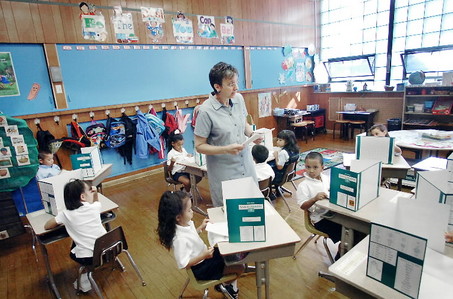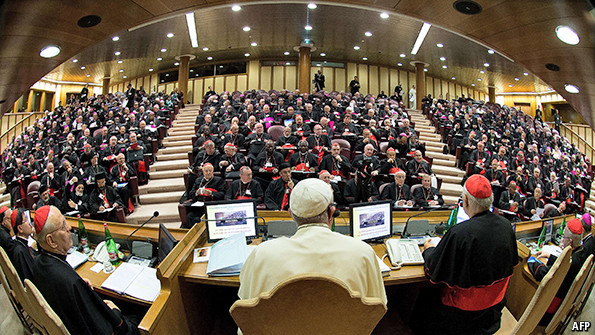Archbishop Cordileone of San Francisco has created quite the stir with his recent policy that Catholic high school teachers in his diocese should “lead their public lives in accordance with church teachings on contraception, sex outside of marriage, and homosexuality.” The Archbishop insists that “the intention underlying this document is not to target for dismissal from our schools any teachers, singly or collectively. . . .”
As being reported though, the policy seems that it will do just that. Every statement focuses on teachers and their actions in isolation from any broader concerns. Below are four ways, two “liberal” and two “conservative”, that would help ensure that the policy does not target Catholic school teachers, who often work selflessly with low pay.
From the “liberal” perspective . . . .
1. Add protections for teachers when accusations are brought against them. The diocese’s policy clearly established grounds for making allegations against teachers, but how are teachers’ rights defended and due process guaranteed? Before I was married, I lived four block from my now wife. We lived in the city, and she had a dog at the time. Occasionally, she would have to leave early before walking her dog. On these occasions, she would call, and I would go over and take the dog to the park for a bit. She would leave her key for me and pick it up on her way home. I never thought twice about it until the principal called her in and asked about her living situation. A parent had seen me walking out of the apartment and told the principal that we were living together. While the principal, also a priest, did not take the accusation seriously and everything turned out well, this approach is not a justice system. By adding fair and clear ways for hearing accusations, adjudicating them, and appealing decisions, the policy would better protect teachers and foster a sense of justice that is essential to Catholic identity.
2. Acknowledge the limits of becoming too Catholic. Many states provide funds for aspects of Catholics schools that do not pertain directly to religious education. These can range from Title One Programs, ESL, school lunches, or textbooks for state mandated classes. If Catholic institutions are judged to be too religious—like if they “exist to help young people attain holiness in their lives, that is, to become saints” as the Archbishop indicated—then this funding can be threatened. This was the case with Catholic colleges and universities in the late 1960’s. As Kenneth Garcia notes in his Academic Freedom and the Telos of the Catholic University, several lawsuits were brought against Catholic institutions claiming that they a) were pervasively Catholic, and so b) should not be eligible for funding from the state. The result was that they were forced to scale back their religious mission, if they wanted to be eligible for government funding. Acknowledging this risk means recognizing the limitations of the policy, encouraging restraint for those enforcing it and providing protection for those falling under it.
From the “conservative” perspective . . .
1. Acknowledge the limits of not being Catholic enough. Part of the debates surrounding the Affordable Care Act was a narrow definition of what constituted a “religious employer” and, in effect, considered Catholic hospitals and schools as not being religious and not eligible for the HHS mandate exemption. In this case, institutions ran the risk of losing exemptions if they were not religious enough. If the policy noted that schools needed enough of a religious perspective to guard against infringements of its freedom, the policy would balance the focus on individual teachers with one for the overall well being of the school.
2. Note that Catholic identity hinges on having Catholics. As Saint John Paul II indicated in Ex Corde Ecclesiae, “In order not to endanger the Catholic identity of the University or Institute of Higher Studies, the number of non-Catholic teachers should not be allowed to constitute a majority within the Institution, which is and must remain Catholic.” However one feels about this prescription, it does seem that you need Catholics to transmit the Catholic faith. This was one of the key themes running through Christian Smith’s Young Catholic America. I also spent two years investigating Catholic identity on Catholic colleges and universities and found that one of the key factors affecting students’ perception of the Catholic identity was the number of Catholic students. (For the argument, see “Student Perceptions of Catholic College and University Religious Identity” in Update and here in the Journal of Catholic Higher Education.) If the Archbishop’s policy takes this broader perspective, it would be more a concern for the Catholic identity of the school as a whole and less on monitoring individual teachers.
There are probably other concerns from both the left and the right, but, without other perspectives to balance or broaden the focus on individual teachers, the policy will become one that de facto targets teachers.





I’ve been in a school where I have overheard the condemnation and overseen the firing of a non-catholic teacher who chose to keep her child (conceived out of wedlock) and then marry the father. Never have I been more convinced that the “Catholic Identity” of diocesan schools is merely a marketing campaign for rich conservative Catholics to send their sons and daughters to a place devoid of any real contact with the poor and marginalized. As a Theology teacher myself, I feel awkward and slightly afraid to sign (or not to sign) the “oath of allegiance” to the bishop.
If Catholic institutions are judged to be too religious—like if they “exist to help young people attain holiness in their lives, that is, to become saints” as the Archbishop indicated—then this funding can be threatened.
Catholic schools exist to help people attain holiness, not attract state funding. This point seems to imply there is some trade-off the school should make in its mission so it qualifies for state funding. It seems to me that the school should first and foremost define its mission as it sees fit, and only then see if state funding is available. Anything else just grants the state some control of the schools Catholicity…